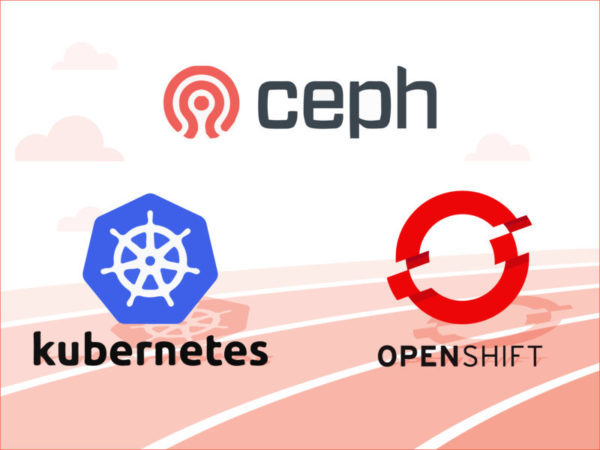- Quick Introduction to Ceph and alternatives
- How to Deploy Ceph on AWS
- Other Ceph deployment strategies for Kubernetes and OpenShift
- How to Monitor Ceph with built-in tools
- How to Monitor Ceph with Sysdig Monitor
- Top 5 metrics to monitor in your Ceph cluster
Ceph Persistent Volume for Kubernetes or OpeSshift
We have our storage cluster ready, but how we can use it within our Kubernetes or OpenShift cluster for Docker container volumes? We have 2 options, store volumes as block storage images in Ceph or mounting CephFS inside Kubernetes Pods. We will follow the first approach for flexibility, performance and features like snapshots. First, we will create a dedicated pool for our images. Make sure you read Ceph Cluster operations: Pools if you run this in production to understand how you choose your number of placement groups. From any Ceph node we will run:# ceph osd pool create test 128 128 pool 'test' createdThen we need to create a block device image inside our pool:
# rbd create myvol --size 1G --pool test # rbd ls -l test NAME SIZE PARENT FMT PROT LOCK myvol 1024M 2Note: if your Kubernetes cluster nodes run Ubuntu, you will have to disable some features as a workaround for bug #1578484:
# rbd feature disable --pool test myvol exclusive-lock object-map fast-diff deep-flattenNow let’s move to our Kubernetes cluster nodes and install Ceph common client packages in all of them:
$ sudo apt install ceph-fs-common ceph-common or if using Red Hat / Fedora / CentOS: $ sudo dnf install cephNext is to copy the keyring to each of the nodes. You can find it in your ansible folder
fetch/{my-cluster-id}/etc/ceph/ceph.client.admin.keyring.
We are now ready to start deploying our Kubernetes or OpenShift entities. First let’s prepare the secret hash from the keyring we have in the ansible folder:
$ cat fetch/{my-cluster-id}/etc/ceph/ceph.client.admin.keyring | grep key|awk '{print $3}' | base64
QVFDS3pJaFlWdTBwTWhBQXJESmFWQXVOZTc5ZEZieTJ1bDBMSGc9PQo=
The secret entity looks like this:
This file contains hidden or bidirectional Unicode text that may be interpreted or compiled differently than what appears below. To review, open the file in an editor that reveals hidden Unicode characters.
Learn more about bidirectional Unicode characters
| apiVersion: v1 | |
| kind: Secret | |
| metadata: | |
| name: ceph-secret | |
| data: | |
| key: QVFDS3pJaFlWdTBwTWhBQXJESmFWQXVOZTc5ZEZieTJ1bDBMSGc9PQo= |
# kubectl create -f ceph-secret.yaml secret "ceph-secret" createdWe will create now a persistent volume:
This file contains hidden or bidirectional Unicode text that may be interpreted or compiled differently than what appears below. To review, open the file in an editor that reveals hidden Unicode characters.
Learn more about bidirectional Unicode characters
| apiVersion: v1 | |
| kind: PersistentVolume | |
| metadata: | |
| name: ceph-pv | |
| spec: | |
| capacity: | |
| storage: 1Gi | |
| accessModes: | |
| - ReadWriteMany | |
| rbd: | |
| monitors: | |
| - ec2-54-215-184-122.us-west-1.compute.amazonaws.com:6789 | |
| - ec2-54-215-203-194.us-west-1.compute.amazonaws.com:6789 | |
| - ec2-54-183-152-97.us-west-1.compute.amazonaws.com:6789 | |
| pool: test | |
| image: myvol | |
| user: admin | |
| secretRef: | |
| name: ceph-secret | |
| fsType: ext4 | |
| readOnly: false |
# kubectl create -f ceph-pv.yaml persistentvolume "ceph-pv" createdAnd finally the persistent volume claim:
This file contains hidden or bidirectional Unicode text that may be interpreted or compiled differently than what appears below. To review, open the file in an editor that reveals hidden Unicode characters.
Learn more about bidirectional Unicode characters
| kind: PersistentVolumeClaim | |
| apiVersion: v1 | |
| metadata: | |
| name: ceph-claim | |
| spec: | |
| accessModes: | |
| - ReadWriteMany | |
| resources: | |
| requests: | |
| storage: 1Gi |
# kubectl create -f ceph-pv-claim.yaml persistentvolumeclaim "ceph-claim" createdWe can have a look at the persistent volumes and claims:
# kubectl get pv NAME CAPACITY ACCESSMODES RECLAIMPOLICY STATUS CLAIM REASON AGE ceph-pv 1Gi RWX Retain Bound default/ceph-claim 1m # kubectl get pvc NAME STATUS VOLUME CAPACITY ACCESSMODES AGE ceph-claim Bound ceph-pv 1Gi RWX 55sLet’s make some use of the persistent volume, creating a MySQL Pod that mounts it on the database path:
This file contains hidden or bidirectional Unicode text that may be interpreted or compiled differently than what appears below. To review, open the file in an editor that reveals hidden Unicode characters.
Learn more about bidirectional Unicode characters
| apiVersion: v1 | |
| kind: Pod | |
| metadata: | |
| name: ceph-mysql | |
| spec: | |
| containers: | |
| - name: ceph-mysql | |
| image: tutum/mysql | |
| ports: | |
| - name: mysql-db | |
| containerPort: 3306 | |
| volumeMounts: | |
| - name: mysql-pv | |
| mountPath: /var/lib/mysql | |
| volumes: | |
| - name: mysql-pv | |
| persistentVolumeClaim: | |
| claimName: ceph-claim |
# kubectl create -f ceph-mysql-pvc-pod.yaml pod "ceph-mysql" createdWe can check inside the container and see how the Ceph block device is mounted:
# kubectl exec -ti ceph-mysql mount | grep rbd /dev/rbd0 on /var/lib/mysql type ext4 (rw,relatime,stripe=1024,data=ordered)Now, we will be able to mount this block device as the Pod moves around our Kubernetes or OpenShift cluster! Still eager to learn more? We were at last KubeCon EU and we loved Kubernetes Storage 101, you should definitely check out!


